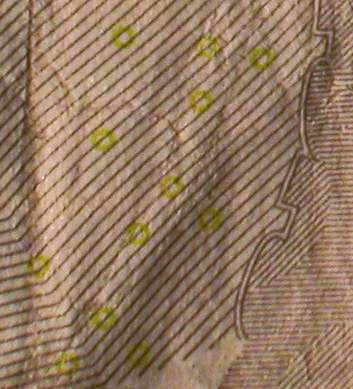Security features of current UK bank notes
Bank note security has been taken to the very limits of affordable technology with the most recent issues of several UK bank notes
from the Bank Of England. They feature several strategies to defeat the would-be counterfeiter.
These include:
- Cotton-based paper, produced in strictly limited quantities by very few manufacturers. Probably the single most effective security device
- Intaglio printing. This is where the ink is raised and is easily felt by hand, almost as if the ink was laid on thick. Fairly hard to counterfeit. Could possible simulate it by stamping the letting from the other side of the paper
- Watermarking. An old favourite, difficult to re-create in a convincing fashion
- Fluorescent ink. Ink that fluoresces under UV light, but does not fluoresce in visible light. So when you shine a UV light source on it, it glows
- Metal thread. Runs the height of the note, only appears in small windows on the obverse [ie not the head side]
- Hologram. On the head side, with intaglio lettering on top of that
- Micro lettering. Very small lettering, particularly in the pattern around the queen's neck
- IR Ink. Ink that does not reflect IR light, in a specific pattern with ink that does.
- EURion constellation. The so-called "EURion" constellation is a series of small circles in a specific arrangement which is designed to be recognised by image manipulation software, and causes that software to deny editing of the image.
The software may be an application on a computer such as Photoshop or Paint Shop Pro, or it may be the firmware in a colour photocopier. If you are unfortunate enough to be using such crippled software, you can always download The GIMP which is Free software, and runs on Linux, Windows and MacOSX.
 Green circles, cropped from a current £5 note, to the left of the Queen's face.
On the £20 note [with Elgar on], they are subtly disguised as musical notes. On the £10 notes they are scattered about the hummingbird's wings.
Green circles, cropped from a current £5 note, to the left of the Queen's face.
On the £20 note [with Elgar on], they are subtly disguised as musical notes. On the £10 notes they are scattered about the hummingbird's wings.
- Radioactive ink. Ink with a specific radiological profile, ie it emits radiation at a specific rate, which can be measured with specialised equipment to verify the authenticity of the note
 Photographed with visible light
Photographed with visible light Photographed with Infra-red light. Notice the change in colour on the left-hand side of the Queen's face
Photographed with Infra-red light. Notice the change in colour on the left-hand side of the Queen's faceFuture strategies
The battle against counterfeiters is something of an un-winnable war; all a counterfeiter needs to do is achieve "good enough" quality to fool just one person, and they've won. Every day, the security techniques used to try and thwart counterfeiters come one step closer to being available "off-the-shelf" to the general public. The most that issuing authorities can hope for is to stay a few steps ahead of the large-scale counterfeiter, and make sure that the barriers to entry are high enough to keep out the nuisance counterfeiter.The problem is that in order for something to be used an everyday authentication method by those responsible for handling money day in, day out, the technology to detect it has to be freely available and easily mass produced; it's no good having an authentication method that only the Bank of England can use. Unfortunately, this inevitably means that the technology used to produce it is freely available and easily mass produced. Technologies to look out for in the future include RFID, iridescent inks and polymer notes instead of paper.